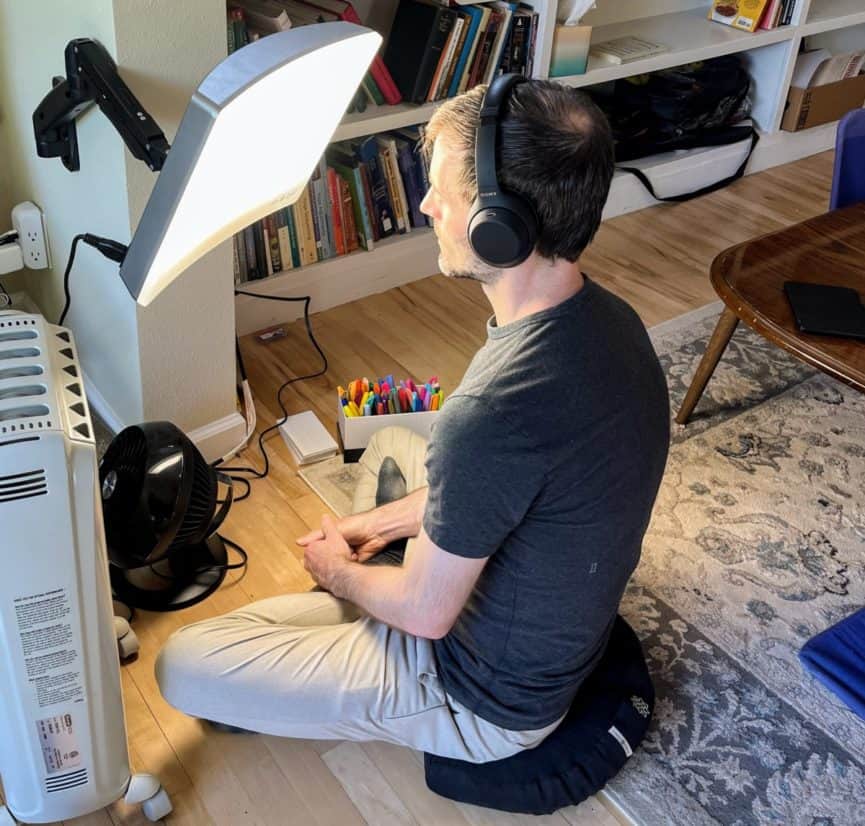In Part 1 of this series, I explained why I think meditation is the most important skill for virtually anyone to learn—especially Thinkers in MBTI.
Today, I’m going to tell you exactly how to do it. I’ll offer an introduction to several different approaches, and I’ll give you my best tips and tricks that I’ve learned over a decade of practicing.
Reading Time: 30 minutes
Before we get started, take a look at the picture at the top of this post.
When I share images of myself publicly, it’s tempting to precisely choreograph them—to arrange my surroundings and my outfit to look professional, cool, or however I want people to see me.
I intentionally did not do that.
I didn’t clean up, and I didn’t rearrange anything to look more serene and minimalist.
I was literally just sitting down to meditate this morning, and I called my housemate over to take my picture.
Why? Because I want to show you that meditation can be quick and dirty. You don’t need your room to look like a yoga studio. You don’t need the perfect cushion.
You just need to sit down somewhere comfortable enough and close your eyes for a little while.
Learning to meditate takes work, but there’s hope
I first tried to meditate in my early 20s, well over a decade ago. I’d read about how meditation can promote neuroplasticity, and I was excited to implement cutting-edge tools for my personal growth.
Unfortunately, after several weeks of solid practice, I didn’t feel any different, so I gave up.
It’s hard for me to imagine now, but I remember deeply struggling to keep my eyes closed in silence for even 5 minutes. I would get bored and fidget, desperately wanting to open my eyes to check how much time was left on the clock.
I would tell myself that this was a waste of my time—that meditation was just for overly-emotional Feelers experiencing some “magical sense of spirituality” when it was just the placebo effect.
But people kept telling me how useful meditation was, so I’d try some new version of it for a few weeks or months before giving up yet again. I was full of judgment, either directed toward myself for not getting it or toward the people who recommended it for being delusional.
I went on like that for years.
But over time, I kept seeing articles describing the incredible neuroscience behind this, and I kept hearing from people I deeply respected that meditation had changed their lives.
So I kept coming back. I tried different types of guided meditation, different physical positions, different times of day, different locations, and more.
Eventually, something began to click.
It wasn’t a single a-ha moment, but more of a gradual change over time.
In this post, I’ll lay out my best guesses about the key pieces that contributed to that shift in me.
And since then, I haven’t looked back. Meditation has become my most consistent daily habit, and it feels very strange to recall that younger self I described. From where I am now, it feels ridiculous that 5 minutes of silence could have been hard.
Even if you’ve struggled for years, it’s worth it.
It might feel challenging right now, but you can learn this skill—even if you’re the most analytical Thinker in the world and it feels impossible to slow down your mind.
I’ve tried a huge number of personal growth techniques and this is the winner.
In fact, so much of the advice I’m seeing today from the top personal development experts, coaches, therapists, doctors, and neuroscientists boils down to mindfulness and meditation.
They might repackage it and reword things to sound more unique or to appeal to various audiences, but the most common thread across all those fields is this: There’s immense value in training yourself to slow things down and observe your present-moment experience.
So, if you could learn just one skill to help you grow, this is it.
Here’s how to meditate, step by step
One note before we get started:
I’m not operating from any specific lineage or tradition here. There are quite a few, and there’s been an immense amount of work from brilliant people over the centuries to develop these skills.
I owe a lot of gratitude to the people who have taught me, and I also want to name that I don’t consider myself to be a meditation teacher. There are people who have devoted years of focused study to this practice, but my aim here is just to help you get started.
As with a lot of my writing, I’m just a layperson who’s good at figuring out complexity, trying different approaches, and explaining it simply.
Ok, here we go!
Step 1: Find the right time and place for you, then aim for consistency.
Pick the right time of day.
For me, I find that meditation is easiest early in the morning.
Back when I worked in the corporate world, I would also successfully practice during my lunch break.
Meditating in the late afternoon can feel much harder for me, so you might find it valuable to try out different times of day and find your own rhythm.
Try out different locations too.
Consider keeping a simple journal where you record where and when you were practicing, then give yourself a score for how easy or hard it was.
Look for patterns, then aim to pick a consistent time and location to build the new habit.
Step 2: Set up your space, and get the basics right—seat, posture, environment.
Find the most comfortable possible seat and posture. Aim to sit up straight, but it’s perfectly fine to have back support—you can even lean back in an easy chair. Laying down is theoretically ok too, but the main danger would be accidentally drifting off into micro-moments of sleep.
Some people like creating a calming ambiance in their meditation space: candles, soothing lighting, inspirational art or quotations, or whatever else gets them in the mood. I don’t go for much of that personally, but do whatever works for you.
Bottom line: You don’t need to be in any kind of fancy yoga pose, and your posture doesn’t need to be perfect. You just have to be comfortable enough that you can concentrate on the practice (but not too comfortable that you fall asleep!).
Again, make sure you’re physically comfortable.
A lot of meditation guides gloss over this piece (“you can meditate anywhere!”), but I believe it’s one of the most important aspects. If you’re uncomfortable and fidgeting the whole time, learning to meditate is going to be a lot harder.
Yes, you can eventually reach a level where navigating physical discomfort just becomes part of the meditation practice. But especially when you’re starting out, make yourself as comfortable as possible.
The discomfort you should be working through is mental and emotional, not physical.
Here are some specific types of seating to try:
Personally, I happily meditated sitting normally in my Ikea Pello chair for years (with the ottoman footrest!).
Then, I shifted to sitting on a “zafu” meditation cushion (the kind filled with buckwheat, widely available on Amazon or at yoga studios). The trick with that is to get your butt up above your feet, which makes it much easier to sit up straight (if you’re just sitting on the floor, your feet and butt will be at the same height and your spine will naturally lean forward).
I want to stress how important that last sentence is: if you’re on the floor, put your butt above your feet. It makes a huge difference.
Here’s the meditation setup I used for the past few years (some days I sat on the chair and some days on the cushion; you can see my SAD lamp too which I’ll explain further down):
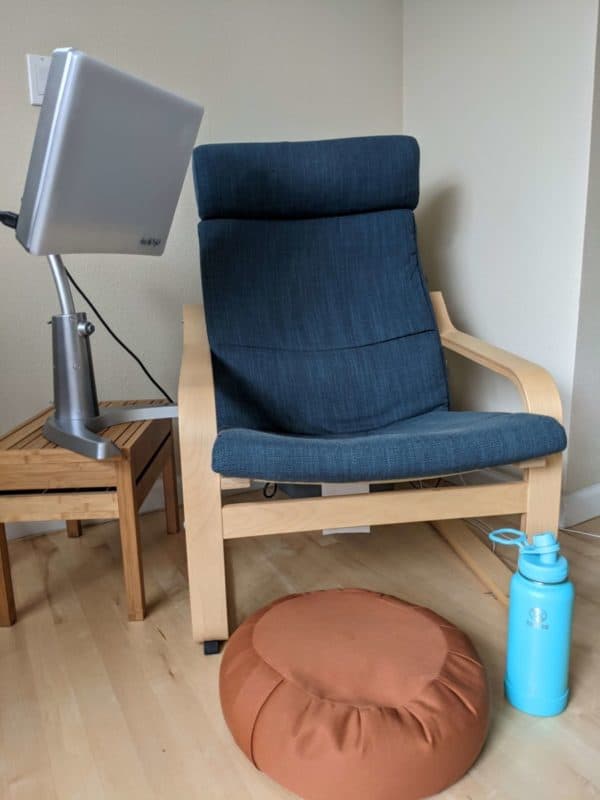
Several months ago, I shifted again:
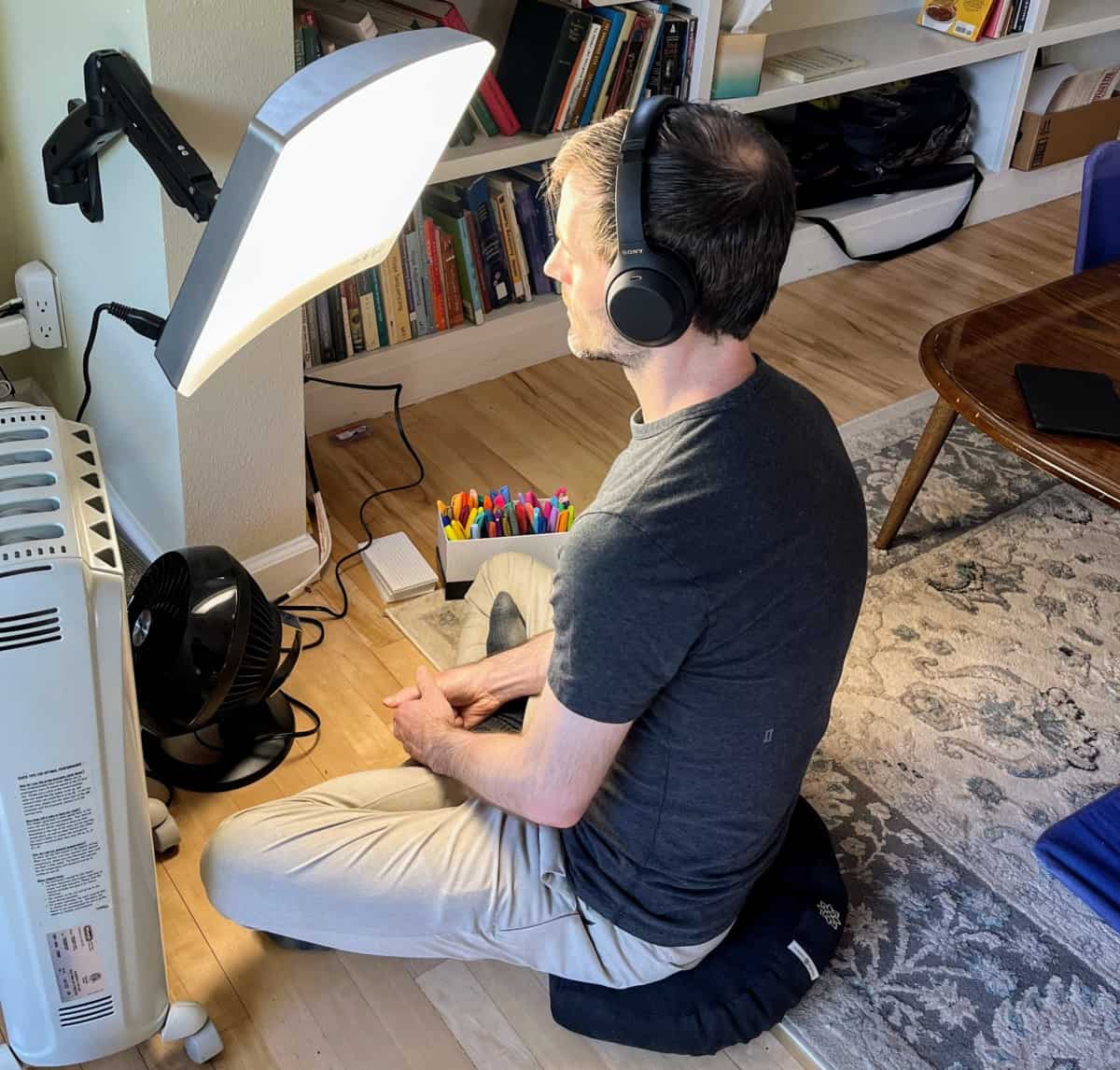
That same Pello chair is to the left of the frame, and I’ve moved my SAD lamp onto an arm attached to the wall so that I can rotate it to either point to my chair on the left or to the right when I’m sitting on the floor. (My usual routine is to meditate on the floor cushion with the SAD lamp on the highest setting, then I turn it down and move to my chair to do some writing.)
For my floor cushion, I’ve switched to this compact buckwheat model since it’s lower to the ground and easier to bring with me when I travel.
For my noise-canceling headphones, these are pricey but amazing (both the active noise canceling and the sound quality for music).
(By the way, some of these are Amazon affiliate links, so I get a very small cut if you purchase that way. But I don’t have business relationships with any of these companies, and I only link to the exact products I already use after a lot of research.)
How to position yourself:
For your legs, you can simply cross them naturally; or, I like to sit in half-lotus position (I feel like it signals to my brain that I’m actively meditating rather than just sitting normally).
Here’s how:
- Start with your legs crossed naturally, meaning each foot will be under the opposite thigh;
- Grab one foot with your hands (I usually grab the left one, and I’m right-handed) and place it above the opposite thigh instead of below;
- If it feels better, let it naturally slide down a bit so that it’s naturally supported above the space where your leg folds (i.e., so one side of that foot is touching the shin and the other side the thigh, with the toes right above the knee). The bottom of the foot should be 2/3 facing upward.
If you’re not very flexible you might slowly work up to it by holding the position for only 30 seconds or a minute at a time.
Here’s my best attempt at demonstrating several possible poses:
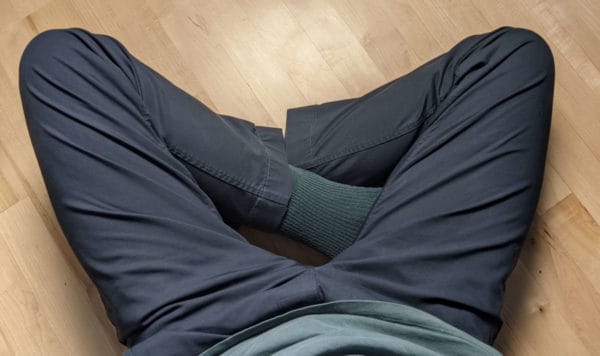
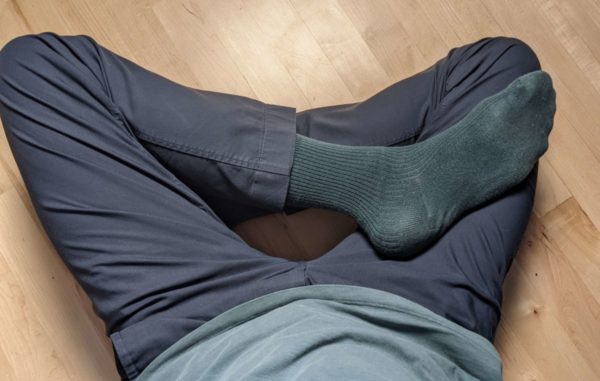
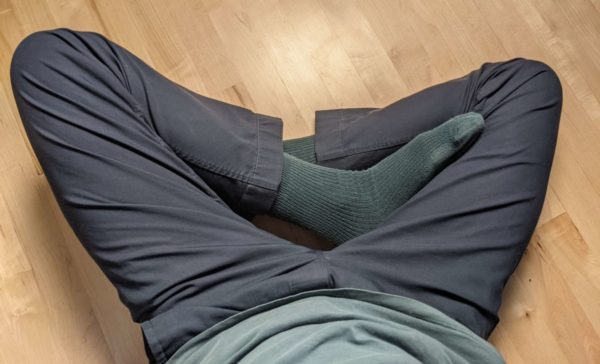
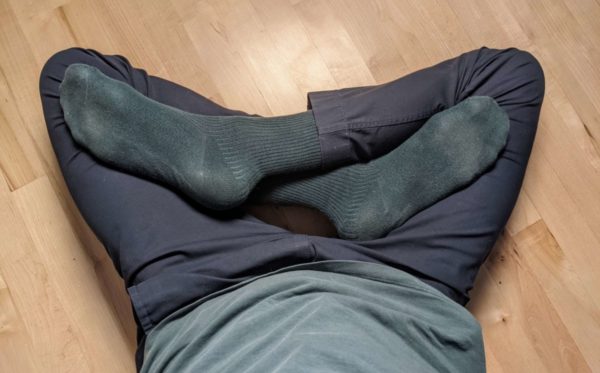
If you’re sitting on a zafu cushion, here are two more specific tips:
- Put your butt on the front third of the cushion, not the middle. Try both to notice the difference. For me, being toward the front of it makes it much easier to keep a straight spine without a lot of effort, whereas when I sit in the center I feel a slight tension in my torso.
- Spread your butt cheeks. Meditation teachers often talk about sitting on your “sit bones,” but all that means is this: Sit down on the cushion in half-lotus or with regular crossed legs. Then, grab your left butt cheek, pull it farther left, and sit that side back down—so that you’re sitting more on the “inside” of the butt cheek than the outside. Repeat with the right side. I know it sounds weird to read all that, but it actually makes a difference—it feels more stable. And if you can’t figure it out, it’s not a big deal at all!
As for the rest of your body, two things:
- Start by looking straight ahead, but then let your chin drop a bit forward. Rather than actively trying to hold your head up, just let it naturally be supported in a way that feels easy.
- Do whatever feels good with your hands. Don’t worry about making fancy mudra poses with your fingers. I usually sit with fingers clasped, but you can put your hands flat on your thighs or whatever else feels easy for you.
Most importantly, relax your body.
The bottom line with all of this is to feel relaxed—not like you’re forcing yourself to stay still and sit straight. Any position is going to be counter-productive if you find yourself agonizing throughout your meditation on trying to keep it “perfect” or you feel a constant low-level tension or pain.
Arrange yourself however feels comfortable, even if that’s lying flat on a couch with a pillow under your head.
Repetitive sounds can help soothe distractions.
Just like how you want to make sure you’re physically comfortable, it’s important to reduce audible distractions as much as possible.
If there’s noise around you, consider using a noise-canceling device or wearing headphones playing soothing, repetitive sounds. There are all sorts of “meditation sounds” playlists available for free on YouTube.
I also like searching for “anxiety frequency” on YouTube—there are a lot of claims out there about certain frequencies helping with anxiety relief. I can’t say that I believe in the power of any specific frequency (though I haven’t spent much time investigating their claims), but I can say that many of those tracks sound soothing to me.
For example (try not to dismiss these just because of the New Age artwork):
My absolute favorite sound to meditate with is available through the free Insight Timer app. It’s the “ambient sound” called “Golden Om,” and it sounds like a group of monks chanting.
But, if all that feels too woo-woo for you, just use white noise or brown noise.
One more thing to fight depression (and boost energy) at the same time:
A few years ago, I got myself a full spectrum light therapy lamp. They’re sometimes referred to as “SAD lamps” (for Seasonal Affective Disorder) or “happy lamps.” They simulate sunlight, and they can be especially useful in winter when it’s darker outside (which can cause depression in some people).
I personally use my lamp every morning year-round.
It’s important to get one that’s powerful enough to create the actual biological response in your body. The research also shows that it has to be kept quite close to your face—within 18″ or so.
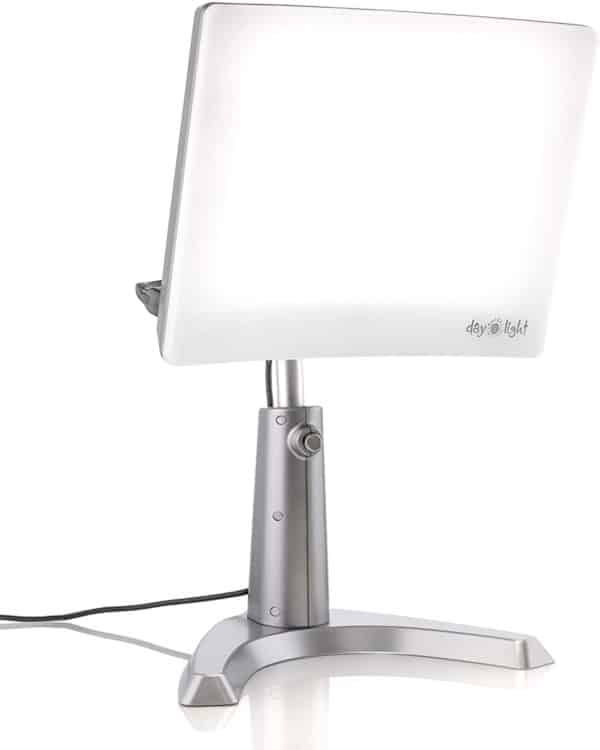
Every morning, I meditate with my SAD lamp pointing right at my face from about 6 inches away (and a little above me, angled downward to better simulate the sun).
(Here’s an excellent Tim Ferriss podcast interview where Stanford neurobiologist Dr. Huberman explains how critical it is to get bright light exposure within 30 minutes of waking, and how your eyes have specialized cells for detecting the angle of the sun to set your circadian rhythm.)
Ok, now that you have your space set up and you’re sitting in a comfortable posture:
Step 3: Check in with yourself.
Lightly close your eyes. Make sure you’re not squeezing them shut. Just keep it natural and easy.
Before you begin the “meditation” itself, take a few moments to notice how you’re feeling in this moment, both physically and emotionally.
What’s the quality of your experience? Are you eager to get this over with? Are you excited? Do you feel time pressure? Are you sleepy?
When you finish, you’ll check in with yourself again, and you can compare how it’s different.
Step 4: Focus on the breath (I’ll offer two ways).
Now that you’re sitting with your eyes closed, there are many different approaches you can take.
The easiest place to start is focusing as much as you can on your breath.
Method #1:
Notice the “in an out” of your breathing. You might try silently naming to yourself “in” as you breathe in and “out” as you breathe out.
Notice where in your body you most feel that breathing. Is it your belly? Your chest? Your nostrils?
Simply try that for a while (“in and out, in and out”), and be gentle with yourself. It’s normal to get distracted.
Method #2:
As I was learning, I found it most helpful to count the breaths instead: “one” on the in-breath, “two” on the out-breath, “three” on the in-breath, etc.
Early on, I would let that go on indefinitely. I even enjoyed gamifying it—keeping a “high score” for myself of how many hundreds of breaths I could reach in a session.
I realized after a while that wasn’t actually serving me. It made the practice stressful and competitive rather than easeful.
Here’s the compromise I recommend: Count to ten (i.e., five full in-and-out breaths), then start back over at one. That way, the counting occupies your mind, but you avoid focusing on remembering your score and comparing it to the past.
Step 5: Remember the secret that most people forget.
There’s something very important that a lot of people misunderstand:
Meditation is not about breathing. It’s not even about reaching enlightenment or any specific goal.
It’s simply about better noticing what’s happening for you.
Focusing on the breath is just a tool for doing that. You could instead choose to focus your attention on, say, the temperature of your skin out in the sun.
Careful: Meditation is also not about holding super tightly to the breath or whatever object of focus you’ve chosen. It’s not: “In-breath, out-breath, in-breath… I have to remember to send that email… damn it, out-breath, in-breath, out-breath, in-breath… My foot is itchy… ughhhhh, FOCUS!”
Meditation is about noticing whatever happens, including distraction. Its about gently catching yourself when you stop paying attention to the breath for too long.
“Failing” is what’s supposed to happen.
When you find your thoughts straying from the breath (or whatever object of focus), that’s not a sign of failure. That’s exactly what’s supposed to happen. Meditation is the practice of noticing when you stray and then gently returning your focus to the breath.
When I say that straying isn’t failure, it’s not a platitude.
It’s just like how strength training is actually about pushing your muscles until microscopic tears form. That way, they can knit themselves back together stronger. When your muscles get sore at the gym, it’s not a failure—it’s literally what you’re striving to do.
Similarly, the practice of mindfulness is about building the muscle of awareness to track what your mind is doing, including when it gets distracted. Then, the muscle of self-mastery is about coaxing your awareness back to the breath.

Step 6: Experiment with different techniques to stay focused:
#1: Numbers:
Keep counting from one to ten—in-breath is 1, out-breath is 2, in-breath is 3, and so on. When you get to 10, start back over at 1. And if ever you catch your thoughts straying away from the counting, start back again at 1 as soon as you notice.
Remember that the point here is not to change your breath but just to notice it. It doesn’t have to be in any specific rhythm or speed. Just count the in-breath and out-breath, however they are.
Remember not to judge yourself harshly if you keep getting interrupted and have to start back over at 1. Noticing that self-judgment and letting it too fade away is part of the practice.
#2: Naming:
Instead of counting, just focus on the “in” and “out.”
If you catch yourself distracted and following a different thought (e.g., “I should get groceries this afternoon”) or a feeling (e.g., “I’m too warm” or “I’m depressed”), literally name it to yourself by saying either “thought!” or “feeling!” in your heard.
Then, gently return your attention to the breath.
As always, I’ll emphasize the “gently” part. This should be less like, “aha, I caught you thinking again!” and more like “ah, hello there, thought.”
#3: Clouds/Waves:
When you notice that your thoughts are straying, imagine yourself looking up at a bright blue sky full of clouds.
Each cloud is a thought. Notice how they gently move across the sky. Allow the thought to gently flow from being the object of your attention to simply fading away off to the side.
Alternatively, you can imagine yourself standing on a beach with your feet in the water. Feel the waves wash in and wash out. When a thought appears, it simply gets washed away on the next wave.
As you experiment with those techniques, I recommend you focus on one at a time for a solid week or two so that it feels easy and familiar.

Choosing to not follow the chain of thoughts:
In all three cases above (numbers, naming, clouds/waves), notice that you’re not actually following the thought down the chain where it leads. The goal is to stay at the first link of the chain.
For example, imagine this sequence of thoughts you might have:
- (Counting the breath) “One. Two. Three. Four. Five. Six. Sev…”
- “Hmm, I’m a little hungry…”
- “I think I have some leftovers in the fridge…”
- “But maybe they’re too old now? When did I cook that again? I think it was…”
Let’s say right there is where you notice yourself thinking rather than focusing on your breath.
In that moment, you’re going to feel part of your brain trying to process that question: “When did I cook that again?”
It’s going to feel like an almost impossible-to-ignore pull toward that line of thinking. You might even hear part of the next sentence begin to form in your mind—something like: “Well, last night I had take-out, so it must have been…”
This right here is the work.
This is the muscle you’re developing.
Part of you is going to want to finish that sentence in your head, but your job right now is to let it remain a “…” at the end. That’s when taking a breath can be handy.
And remember the gentleness.
Don’t push hard against that next thought in the chain by forcibly thinking, “No, no, no, don’t think about that!”
It’s more like when you notice that you’ve been sitting in an awkward position for a while. You’d been lost in thought, so you suddenly realize there’s discomfort in your leg. In that moment, you don’t need to suddenly jump up and make a dramatic adjustment to your body. You just need to softly shift your attention to your leg and then gently move it.
Step 7: Explore following the thoughts.
Now we’re getting a bit more advanced.
I encourage you to try out those three techniques for a while to stay focused and not follow your thoughts down the chain.
But.
Once that starts to feel comfortable—which might very well take months—you can experiment.
What happens when you allow yourself to follow thought-chains for just one link? Two links? Three links? Can you develop that kind of control?
In my experience, this has led to some wonderful places—thoughts and connections I wouldn’t have reached otherwise. It’s led me to experience deeply pleasurable sensations and emotions, almost like basking in the warm sun.
It’s easy to get carried away, though—to begin analyzing problems, finding solutions, and getting stuck on the past or the future. So make sure you’re already comfortable with the basic practice of stopping the chain entirely before you try venturing down it.
To be clear, the basic practice is noticing “thought!” and immediately (gently) returning to the breath. The more advanced practice is noticing “thought!” and sticking with it for an extra moment: “interesting, there’s a thought, and I’m noticing now that I’m being pulled toward a second thought… ah, there it is,” and then returning to the breath.

Once you feel ready, choosing to follow your thoughts can feel like surfing.
If the beginner meditation is standing still on the beach as the waves wash in and out, following your thoughts is like choosing to allow those waves to pull you out once in a while. To let yourself be led along on your surfboard to wherever the current takes you.
In each moment, you can choose to:
- Stay riding that particular wave (i.e., keep following that thought-chain);
- Switch to a different wave that intersects it (i.e., notice a branching point in your thoughts where you could choose to follow chain A or chain B);
- Return to shore (go back to counting your breath).
This more advanced skill is allowing yourself to be taken to other place without losing control.
It’s allowing your analytical mind to observe but not to grab the steering wheel and take over.
Think about all the applications this skill could have in your life: retaining your focus on an important project, losing your temper less, paying better attention when a loved one is talking, etc.
This post is about meditation, but working this muscle is ultimately about building the skills of internal self-command and self-mastery.
It’s allowing your powerful core self to be in charge.
I know that might sound New Agey, but consider an analogy: If you’re drinking at a party and start to feel tipsy, your “core self” might know that you’re in danger of doing something stupid, but a different part of you might do it anyway.
By strengthening your self-command muscle, your core self can become powerful enough to keep the other parts of you in line even if you’re being distracted or led down a path that’s not right for you.
Step 8: Start slow. Take your time. More isn’t better.
It’s harder than you might think to keep away from your thoughts, especially as a Thinker in MBTI. For most people, this is a completely new skill and unlike anything they’ve had to do in life before.
So don’t push yourself too hard or you’ll be more likely to give up.
Instead, I recommend starting with one minute a day.
Do that for a week. Then, if you were able to stay relatively calm and focused throughout, increase to two minutes, and so on.
Once you reach 5 minutes, you might stay there for a few weeks. Same at the 10-minute mark.
Consider remaining at the 15-minute level for several months. It might be interesting to explore 20 minutes and 30 minutes too, but for most people 15 minutes a day is a great place to stop.
Personally, after over a decade of doing this—at 15 then 20 minutes/day for many years—I’ve settled into a routine of just 7 minutes every morning. I’ve found that’s my sweet spot where I’ll get a lot out of it but also not dread meditating or put it off when I’m busy.
Doing something every day is more important than any specific duration.
Some days I’ll even just do 5 minutes if I’m in a real hurry. And, some days I’ll do an additional 10-minute meditation in the afternoon. I’ve been trying to fit in a second daily meditation more consistently, but I’m also not pushing myself too hard because I want the practice to feel easeful.
Remember: 1 minute or 5 minutes of meditation is far better than zero. So find your sweet spot where you’ll actually do it instead of finding an excuse or “making an exception.”
(If you feel like you might have trouble getting started with a new daily commitment, I recommend my posts on habit formation.)
By the way, make sure the timer you’re using has a pleasant alarm sound. The last thing you want is for your gentle meditation to end with a jarring alarm clock.
Step 9: Allow natural cycles, and find your groove.
I encourage you to think of meditation not simply as a skill you learn but as a state of mind to cultivate.
It’s less like learning a specific framework for programming apps and more like deciding that you’re the type of person who programs apps, even if you haven’t considered yourself to be technical before.
Similarly, this is about organizing your life in a way that prioritizes the practice of meditation, even for just one minute a day.
Again though, be gentle with yourself.
I’ve gone through periods over the years where I’ve given myself one day a week off. Freedom is important to me, so I’ve liked the idea of not being locked into to any habit every single day forever.
But, I’ve noticed over the past few years that, even with that freedom, I still choose to meditate virtually every day. It just offers me too many noticeable benefits to ignore, and it’s become a core part of who I am.
The important thing is to not beat yourself up if you miss a day. Meditation should ideally help you cultivate a state of mind rooted in tranquility and self-compassion, so don’t hold on to any of this too rigidly.
Remember: The goal is simply to notice your experience of the moment.

There have been times over the years where I’ve stopped meditating for several months. But I’ve always come back when it’s felt right.
Just like the tide coming in and out regularly, I believe it’s important to allow the natural cycle of your energy to ebb and flow. Depending on your living environment, career responsibilities, relationships, hobbies, and so on, it’s natural to find yourself more drawn to meditation for a while, then to notice you’re not prioritizing it as much, then to feel drawn in again when something changes.
This is a lifelong practice.
Tune in next time as I wrap up this series in: Part 3 (in progress): Different styles, traditions, teachers, apps, and more; plus, a 12-week learning schedule you can use, and my series takeaways.

